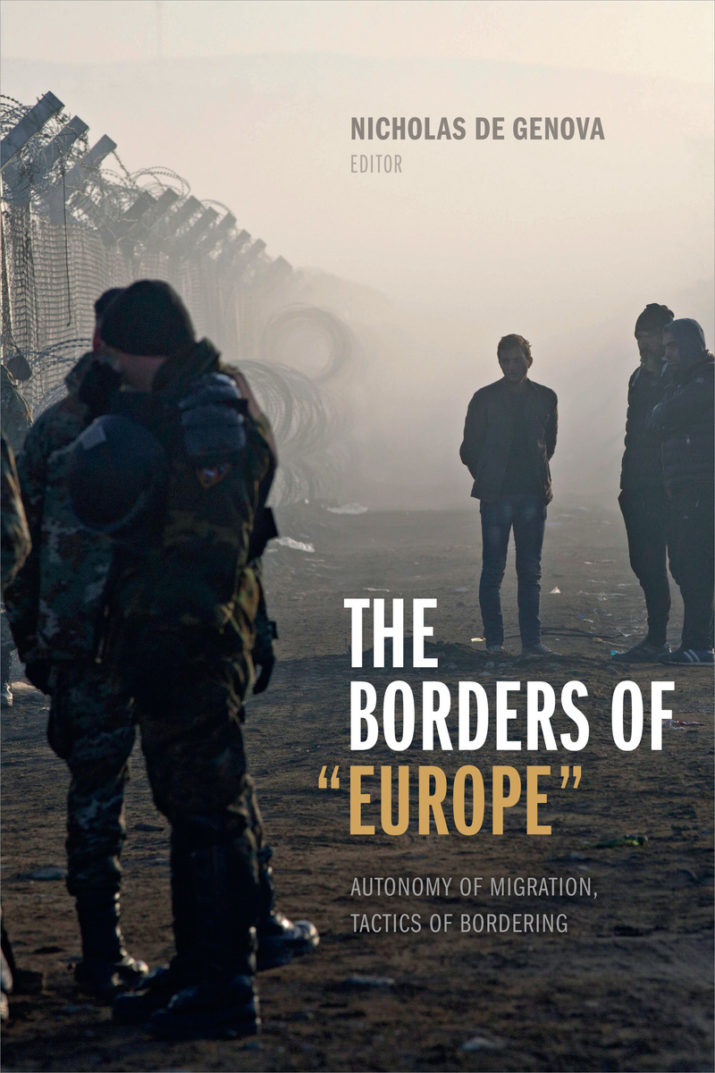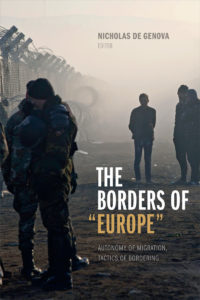

This is part of our special feature, Beyond Eurafrica: Encounters in a Globalized World.
The last few years have left their mark on the history of humankind with the deadliest shipwrecks known to the Mediterranean, unnumbered capsized “migrant boats” trying to reach the European shores, and dead bodies washed ashore after failed attempts to cross European maritime borders—such as Aylan Kurdi, a Syrian boy trying to reach the Greek Island of Kos from Turkey. The media and European authorities quickly defined the emerging predicament as a migrant/refugee “crisis,” though sometimes labeled it as a humanitarian “crisis,” other times a security “crisis,” and also a “crisis” of social order. Nothing is more emblematic than the shifting significance of Aylan Kurdi’s iconic image in this regard. A few months after becoming a symbol of humanitarian crisis, Aylan’s famous image was duplicated on the cover page of the French satirical magazine Charlie Hebdo under the title “Migrants: What would little Aylan have become if he had grown up?” asked the French satirical magazine. The answer read: “Ass fondler in Germany.”
The Borders of “Europe,” edited by Nicholas De Genova, takes up this putative migrant or refugee “crisis” in Europe and problematizes its three main aspects: 1) the codification of the basic human freedom of movement as “migration” and in general the ambiguity and ambivalence that haunts all labels (refugee, asylum-seeker, migrant) assigned to people on the move; 2) the strategic and political purposes the naming of the “crisis” serves, and 3) the question of “Europe” and “European”-ness at the core of the European (post)colonial migration and border regime. De Genova and most of the contributors to this volume have been interrogating these issues within the collaborative project of the New Keywords Collective focusing on the “crisis” in and of “Europe” (New Keywords Collective 2016) initiated in the immediate aftermath of the Charlie Hebdo shootings in January 2015. Their objective is twofold. First, they destabilize and deconstruct the taken-for-granted terms, “crisis,” “migrant” crisis/ “refugee” crisis, “mobility,” and crisis of “European values” in order to reveal the inherent ambiguities and ambivalences. Second, they examine the reality produced, ordered and organized around these terms. The Borders of Europe is comprised of Nicolas De Genova’s erudite introduction that presents the basic premises of this critical framework against the backdrop of events in recent years, and eleven individual chapters problematizing Europe, migration, and borders based on ethnographic analyses at various border zones ranging from Mellila to Latvia and Choucha to Istanbul.
Autonomy of Migration
Theorized and complicated in various ways, the primacy of mobility—or the Autonomy of Migration (AoM)—is the undergirding idea of this volume. This approach challenges the dominant portrayal of migration as a response to structural needs and pressures such as pull and push factors, and migrants as passive, vulnerable victims. In contrast, the AoM approach celebrates migration as an uncontrollable, stubborn, independent force that escapes governmentality. As Hardt and Negri capture this sentiment: “A specter haunts the world and it is the specter of migration. All the powers of the world are allied in a merciless operation against it, but the movement is irresistible…The legal and documented movements are dwarfed by clandestine migrations: the borders of national sovereignty are sieves” (Hardt and Negri 2001, 213). As De Genova also argues, only by acknowledging the primacy of human mobility can we perceive the significance, materiality and productivity of border controls, which are nothing but reactive tactics in response to human movements that throw putative state sovereignty over borders into “crisis.”
Stephan Scheel, Maurice Stierl and Clara Lecadet contribute to the Autonomy of Migration approach in various ways. In their respective chapters, Stephan Scheel (Ch.1), Maurice Stierl (Ch. 8) contribute to the discussion regarding the capacity of migrants to subvert, mock and overcome border control. Scheel uses the Schengen visa system as a lens to examine the reality created through encounters between the autonomy of migration and a European border regime. Drawing on his fieldwork at various consulates in North Africa, he investigates the ways in which people “subvert border controls and defy migration policy objectives.” In order to go beyond the agency/structure dichotomy and examine the mutually constitutive relation between autonomy of migration and border control regime, Scheel uses the notion of “appropriation” and suggests that migrants subvert border control mechanisms put into place to regulate their own mobility by appropriating them to repurpose, recode the actors, devices and methods of control. Stierl on his part offers a more cautious approach that complicates AoM’s glorification of migration’s supposed resistance to governmentality. Instead of seeking to find moments and episodes of hopeful anonymity, autonomous escape, or migration’s supposed primacy, one should begin the analysis, he thinks, with border entanglements itself. Drawing on Foucault’s short essay Lives of Infamous Men and based on his ethnographic research in Greece on migrants stuck in transit, Stierl suggests that migrants are “subjects able to be traumatized and resistant, scared and hopeful, captured and recalcitrant” (231).
Clara Lecadet (Ch. 5) in her turn scrutinizes the constitutive role of the autonomy of migration from the perspective of the expellees. Using the Malian Expelled Migrant Association as a lens to investigate the issues ensuing from European return policy, Lecadet discusses the possibility for expellees to become political actors and as such renders the expelled migrant visible to emphasize their role in transnational struggle over the production of the European border regime.
Epistemological “Crisis”
The first instance of the “crisis” that arises from the encounter between autonomy of migration and bordering, De Genova argues, is an epistemological one and concerns the naming, classifying, and ordering of human mobility itself. The question European authorities pose and the media coverage of the border spectacle revolve around the question of who is a bogus or bona fide “refugee,” who is a mere “economic migrant,” and who is an “asylum seeker,” as if these statuses are intrinsic to subjects on the move. In various chapters of this volume, the contributors examine the legal and political processes in which the European border regime itself produces these categories and implicates people on the move not only by governing but also non-governing or abandoning them. Fiorenza Picozza’s chapter (Ch. 9) where she scrutinizes the Dublin Regulation deserves special attention in this regard. Under the Dublin Regulation, migrants can be deported “back home” or also to a “safe third country” or to non-EU countries that adopted Dublin Regulation. Furthermore, once protection is obtained under domestic regulations, refugees cannot work and reside elsewhere but that particular country. As the distinction between legality and illegality gets blurred and both asylum-seekers and recognized refugees are subjected to “deportability” as a result of these regulations, Picozza uses “Dubliner” as an analytical category to interrogate how the EU border regime implicates all people on the move. Extending the label of “Dubliner” to all migrants and refuges, Picozza aims first, to reveal the ambiguity and ambivalence that haunts the migration management discourse and its administrative categories such as “economic migrant” or “refugee” and second, to examine the legal, sociopolitical and existential effects of these labels on the migrants as they internalize them, thus affecting their everyday experiences of time, space, embodiment, sociality, and self.
Governmentality of the European Border Regime
Notwithstanding the ambivalence inherent in the naming, categorization and classification of the people who exercise their essential freedom of human mobility, the “crisis” discourse creates a reality where the putative migrant or refugee “crisis” is equated with a “crisis of control over the ostensible borders of Europe.” Thus the crisis discourse also operates as a “device for the authorization of exceptional or emergency governmental measures towards the ends of enhanced and expanded border enforcement and immigration policing,” which is only further exacerbated by the association of refugees or migrants with the terrorist attacks of 2015 (9). The Borders of Europe offers crucial insight into the governmentality behind the European border regime, the ways in which it operates, is enforced, and also is contested in various ways by thousands of people on the move. The chapters by Charles Heller and Lorenzo Pezzani (Ch. 3), Ruben Andersson (Ch. 2), Glenda Garelli and Martina Tazzioli (Ch. 6), and finally Dace Dzenovska (Ch. 11) in particular address these issues.
Charles Heller and Lorenzo Pezzani’s contribution is remarkable in terms of offering an insight into the governmentality of the European border regime in the Mediterranean Sea, which they developed through their project Forensic Oceanography. The project was launched in the summer of 2011 to document the crossings and deaths in the Mediterranean Sea ensuing the Arab uprisings. As such the primary goal of the project was “repurposing the technological apparatus of sensing to bring the sea to bear witness to how it has been to made kill” (96) as it was the case in an incident known as the “left-to-die boat,” in which sixty-three migrants lost their lives while drifting for almost two weeks in the NATO maritime surveillance area despite numerous encounters with a military ship. However going beyond mere documentation of specific incidents, Heller and Pezzani use the project to account for the rationality operative behind the governance of Mediterranean Sea, which they define as a militarized governmentality of mobility that inflicts deaths by first creating dangerous conditions of crossing, and then abstaining from helping those in danger.
Europe’s response to the migrant or refugee “crisis” actually varies from a securitarian approach to a humanitarian one as exemplified by European Commission’s demand for smoother asylum procedures or Italy’s rescue operation Mare Nostrum, which baffled many scholars. Ruben Andersson (Ch. 2) takes up this issue of seemingly contradictory humanitarian and securitarian approaches equally prevailing in Europe to suggest that these ostensibly opposite approaches are in fact enmeshed and entwined at the borders in mutually reinforcing ways (65).
Glenda Garelli and Martina Tazzioli (Ch 6) in their turn examine the governmental rationality enacted by the humanitarian actors themselves using the UNHCR and its Choucha refugee camp as a lens. UNHCR opened the Choucha refugee camp in Tunisia in 2011 for people fleeing the Libyan turmoil, including those—mainly from African countries—who had been living and working as migrants in Libya. Choucha in this regard, the authors argue, was the first international laboratory for a specifically humanitarian politics of migration containment and as such contributed to the externalization of EU migration and border politics to the third countries through deployment of a “humanitarian borders.” However, not all Choucha residents were given refugee status. Garelli and Tazzioli focus exactly on those who were abandoned by the humanitarian regime and produced as “people not of concern” and illegalized as mere migrants. The authors define this abandonment yet another form of governmentality, that is as “governing by non-governing,” which, by producing illegality, contributes to further vulnerabilization of refugees.
Finally, Dace Dzenovska (Ch. 11) studies “reporting” as a technology of government, which—although associated with totalitarian states— is a constant practice of late liberal societies as well, where freedom is not abandoned altogether but accepted as a public good. Using “state socialism” as a “portable analytics,” Dzenovska compares the Latvian State Border Guard and the British Home Office to examine the similarities and differences of subjects and socialities assumed, deployed and produced in these examples.
European Question
The contributors to this volume further elucidate the serious implications of the “crisis” discourse with regards to the ostensible inside/outside of European space and European-ness. Migration or refugee “crisis” implies, first, that these “crises” erupt “elsewhere,” simultaneously constituting an idea of Europe—as a safe and stable bounded entity—presumably under the threat of those “external” problems. The contributors defy this sort of methodological Eurocentrism and destabilize the inside/outside binaries underlining the fact that “virtually all migrations and refugee movements that today seek their futures in Europe have been shaped by an indisputably European (colonial) past” (18). Nevertheless, it is precisely this binary distinction between the European space and its putative “outside” that today enables “Europe” to externalize the border control mechanisms and engage the former colonies in Africa, as well as the EU and non-EU European countries alike in the European migration and border regime. As De Genova argues, the ensuing borders of Europe are thus not outward projections of a stable coherent center, but the “the materializations of sociopolitical relations that mediate the continuous production of the distinction between the putative inside and outside and mediate the diverse mobilities that are orchestrated and regimented through the production of that spatial divide” (21). In other words, European spatial boundaries—without a center and corresponding physical geography—are continuously (re) produced and contested deconstructing all the inside/outside dyads through which Europe conceives itself.
Laia Soto Bermant (Ch. 4) problematizes the “question of Europe” considering one of its most controversial borderlands, Melilla, a Spanish enclave in Morocco. As she examines, since the 1990’s when Spain joined the Schengen area, Melilla became a first line of defense in the control of migration flows into Europe. The securitization of borders go hand in hand with a complex system of selective permeability designed to facilitate informal trade flows and also echoing the colonial history against which European-ness is reconstructed on a daily basis through systematic discrimination and exclusion. As such Melilla offers a lens through which one can see the constitution of Europe as a political, economic and cultural project.
In his turn, Souad Osseiran examines the ways in which Europe and the EU space are constructed in the imaginations of Syrian refugees in Istanbul. We learn from Osseiran that migrants/refugees conceptualize Europe in ways that go beyond and fragment what is deemed to be or enforced by EU institutions as a fixed, stable bounded entity. Considering the constant negotiation and interplay between “autonomous movement” and “tactics of bordering,” Osseiran (Ch. 7) suggests that migrants never cease to account for and appraise the border control strategies in their narrations, yet they do not take these “borders” as the given and definitive limit of their imagined spaces. As such, their imaginings of a more fractured Europe opens up the possibility of other Europe(s) different from those demarcated and enforced by the constrictions of EU institutions and European elites in their campaigns of control.
The terrorist attacks in Paris, hastily associated with Syrian refugees, and the moral panic over multiple sexual assaults in Köln/Cologne during the New Year’s Eve festivities shifted the “crisis” from the spatial borders of Europe into one that concerns the entire fabric of European social order, calling forth emergency measures and mundane policing to protect “European values” (17). De Genova takes up the “crisis” of European values and the preoccupation of all Europe with the Migration Question to destabilize what Europe and European-ness stand for in these dominant discourses. Employing a deconstructive reading, he suggests that European identity, like its spatial borders, lacks a coherent center. As an elusive signifier, its meaning thus depends on a constitutive Other, defined by the “lack” of presumed European values. What awaits scrutiny is therefore not migration per se—as the mainstream migration studies purport—but rather it is Europe itself, seen from the vantage point of cross-border mobility of migrants. Such an interrogation of the European Question (De Genova 2016) as De Genova calls it, sheds light on the repressed, yet to be acknowledged colonial racism rampant today in the ways European-ness and non-European-ness are constituted in relation to the right to mobility. In the individual chapters, the contributors examine how the borders of Europe are entangled with a global politics of race that “refortifies European-ness as a racial formation of whiteness, and a comparably global neoliberal politics of transnational labor mobility…that produces such spatialized and racialized differences…to capitalize upon them” (21).
Focusing on Gran Ghetto, a small migrant settlement in Southern Italy, Evelina Gabino studies exactly the ways in which the Italian state, through management of migrants’ mobility and the creation of a wide range of illegalities, creates profitable conditions for labor exploitation by capital. However, that does not mean that migrants are the passive victims of thus emerging structures; it is the opposite. Though invisible to official narrations and adverse to mainstream political organizing, there is actually a migrant network—a human infrastructure designed by migrants’ interactions. Gran Ghetto, as Gabino suggests based on her militant activism, is thus also a site of solidarity and struggle through the interventions of Campagne in Lotta, a new form of organization that privileges relational communing and “penetrates the global space of ever-expanding abject ‘migrant metropolis’ growing within and despite the borders of Europe” (281).
Taken together, The Borders of “Europe” presents a great methodological contribution that challenges and changes the ways in which Europe, migration and borders are thought about and analyzed. A Foucauldian “history of the present” committed to problematize the “coloniality of power” in the current European migration and border regime combined with a deconstructive reading employed to destabilize and provincialize Europe are shared features of the individual contributions to this volume. What is most remarkable is that the contributors to the volume did an amazing job in firmly grounding their sophisticated theoretical analysis in rigorous fieldwork.
That being said, the individual chapters could have been grouped according to certain themes or regions, which would help direct the reader. As it is, the chapters are listed one after another without an apparent organizing logic behind. Nevertheless, The Borders of Europe is a must read for all those interested in Migration Studies, Border Studies and European Studies.
Reviewed by Özden Ocak, Denison University
The Borders of “Europe”
Edited by Nicholas De Genova
Publisher: Duke University Press
Hardcover / 376 pages / 2017
ISBN: 978-0-8223-6888-5
References
De Genova, Nicholas. 2016. “The European Question: Migration, Race, and Postcoloniality in Europe.” Social Text 34 (3), 128: 75–102. https://doi.org/10.1215/01642472-3607588.
Hardt, Michael, and Antonio Negri. 2001. Empire. Harvard University Press.
New Keywords Collective. 2016. “Europe/Crisis: New Keywords of ‘the Crisis’ in and of ‘Europe.’” Near Futures Online 1 (1), 1-45.
Published on March 1, 2018.




